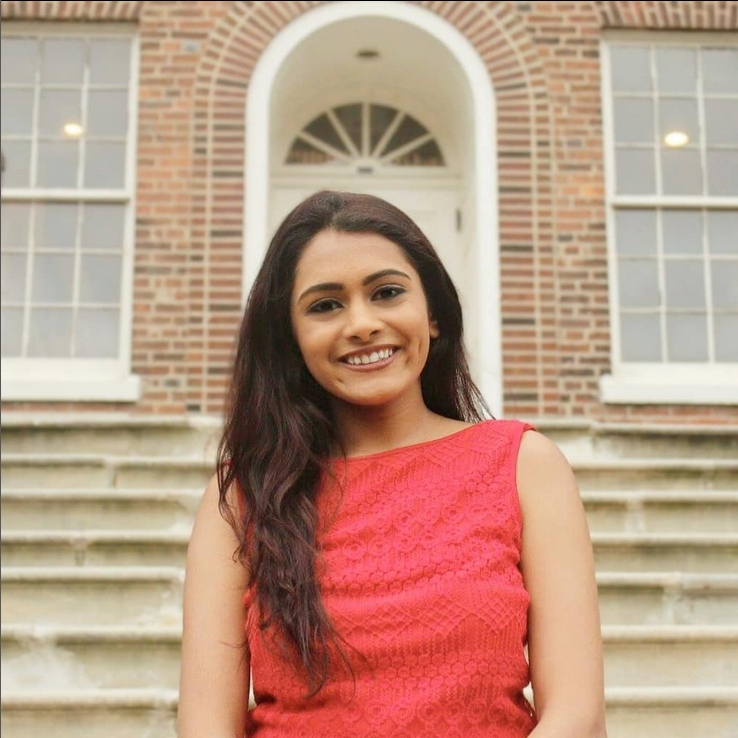

Over the past year, as Writer-in-Residence at Distributaries, I’ve had the privilege of speaking with several public humanities practitioners scattered across the CUNY campuses. I picked their brains about a range of topics: how they understand the term ‘public humanities,’ how they see their public humanities/public scholarship initiatives taking shape within and against the conditions of severe austerity plaguing CUNY and the humanities more broadly, and what they understand the public service commitments of a university like CUNY to be, among other things.
Something I found myself returning to over and over again, considering the broad scope of the initiatives and projects that these practitioners were knee-deep in, was how each one defined their audiences; their responses, as expected, were multifaceted: Rosamond King spoke about how her mother is the audience she considers for all her writing outputs, both creative and scholarly; Michelle Fine considered how the people that researchers might be accountable to, in their publicly-engaged work, might not necessarily overlap with the audiences that their research outputs hope to reach; Annie Valk highlighted how one’s publics might in fact be situated in the university, rather than outside of it.
These thought-provoking conversations led me to meditate on who the ‘public’ in ‘public humanities’ is, and how one might go about identifying the publics for their work. The following think-piece grew out of these reflections.
—Queenie Sukhadia
The ‘public’ in ‘public humanities’ appears to function almost as a catchall for those that don’t inhabit the university in a scholarly or professorial capacity. Yet, in spite of being deployed as an uncomplicated shorthand, the ‘public’ actually represents a multi-faceted, complex group of people. When we think of the ‘public’ in direct opposition to scholars/professors, we end up populating both these identities with artificial content—derived, on the one hand, from a mythologization and reification of those within the university and, on the other, from a caricaturization of those outside of it. Scholar-professors are represented as intelligent, erudite ‘experts,’ while the ‘public’ is transformed into their immediate antonyms—naïve, uninformed non-experts. This dichotomous pairing may seem convenient, flattering even, for those of us within the university, but it’s ultimately fabricated, patronizing, and detrimental to any socially just work we may seek to accomplish through the channel of the ‘public humanities.’ In this essay, I offer questions and models of thinking that may help us unbraid this monolithic and ossified concept of the ‘public’ into distinct, rich, and capacious threads that can enliven our public humanities efforts.
One way to think the abstraction of the ‘public’ into tangible form is to rearticulate the aims or goals of our public humanities projects in terms of a concrete audience. Who are we trying to engage through our work? Who would we want to present our work to? Asking these questions is a crucial first step in identifying a circumscribed audience for our projects. It’s also important to recognize that these audiences may be multiply situated. For example, a pop culture scholar writing about Breaking Bad may want to engage the show’s fan base, but this fan base may be scattered across various locations and workspaces—an American university’s English Lit department, an Indian living room, a Silicon Valley conference room, and so on. Identifying a well-defined audience, in this way, presents an opportunity to dismantle the simplistic university-public dualism we lean on, while also enabling us to imagine our ‘public’ as painted in various stripes. Additionally, as we seek to identify audiences for our public-facing work, it may also be helpful to flesh out this audience through concrete attributes, to place them within complex sociopolitical contexts—what are these people like? Where do they live? Which socioeconomic brackets do they inhabit? Such enfleshment is particularly valuable for thinking our ‘publics’ in more three-dimensional terms—an imaginative generosity that can feed back into and further nuance our projects.
“Who are we trying to engage through our work? Who would we want to present our work to?”
Another frame for thinking our ‘publics’ is that of service and duty. Whose needs are we trying to meet through our projects? Who do we hope to be accountable to? These questions are crucial for several reasons, beyond helping us articulate the specific attributes of the publics we’re hoping to reach. Framing our work in terms of responsibility suffuses it with care. Our scholarship or public-facing projects can no longer sustain an intellectually detached posture, then; they can no longer be animated by mere curiosity. Accountability is heavy. It encourages us to decenter ourselves in favor of the work we’re undertaking and the communities we’re doing this work for. Asking service-oriented questions helps us reflect on impact rather than intent. It allows us to minimize egos as ‘credentialed experts’ so that we can direct our energies to the task at hand instead. Centering duty also repositions us within networks; it conjures up a sense of embeddedness, challenging the individualist mythologies of the university—of itself as a sequestered ivory tower and of its scholars as solitary geniuses, unraveling the complexities of the world while being insulated from its busy whir. Moreover, adopting this mindset of service when conceiving of our publics compels us to ask after their needs. It stimulates supplementary questions, such as: what do we need to be attentive to in order for our work to fulfill its responsibility towards actual people? What do we need to learn? And more importantly, what do we need to unlearn?
“Whose needs are we trying to meet through our projects? Who do we hope to be accountable to? […] Framing our work in terms of responsibility suffuses it with care.”
We can also route our inquiry into the ‘public’ through the prism of conversation: Who do we want to converse with through our work? Who do we want/need to invite to the table and work alongside? These questions open up the possibilities of collaboration and response. They emphasize mutuality and horizontality, holding space for our publics to speak back to us, whether in consensus or dissensus. Reflecting on whom we want/need to work alongside also accomplishes the crucial task of positioning us—those within the university—as a public, one among and alongside others, sharing the identity of those we’re collaborating with. In our scholarly roles, we often think about labor and how capitalism compels us to center work in our identities; yet, when it comes to ourselves, we forget that the university is also a workplace. Being scholars and professors is how we define ourselves as workers in the knowledge economy, but these labels are too inelastic to effectively capture all that we are.
Defining ourselves, university-affiliated public humanists, as a public also yields another fertile opportunity: if we’re a public just like those we’re collaborating with, can we not, through our projects, help pave pathways for other publics to speak back to us? By this I mean: if the public humanities are a conversation, where we, the publics within the university, are creating channels to intervene in the milieu of publics outside the university, why not strive to make these channels bidirectional such that outside publics can find their voice within the university as well?
“If we’re a public just like those we’re collaborating with, can we not, through our projects, help pave pathways for other publics to speak back to us?”
Conversation stretches across time. It began before we joined it and will continue long after we leave. As we sink into our public humanities work, positioning our publics as conversation partners serves as an important reminder for us to situate ourselves as participants rather than protagonists; we’re engaging in a conversation, not leading it. As I hope to have illustrated here, and across the interviews I’ve conducted this past year, sitting with the idea of the ‘public’ and what we imagine this nebulous concept to be is critical to the larger enterprise of the public humanities. Besides the wholly practical effect of refining the aims and methods of our public humanities endeavors, defining the ‘public’ helps us uncover and center the relationalities driving our work. It forestalls the petrification of the public humanities into a rigidly defined discipline, instead making this field fluid enough to bend in various ways to reach diverse communities. It makes us public humanists humble, reminding us that we are with them and they are with us.
Read Queenie’s full interview series with public humanities practitioners across CUNY below:
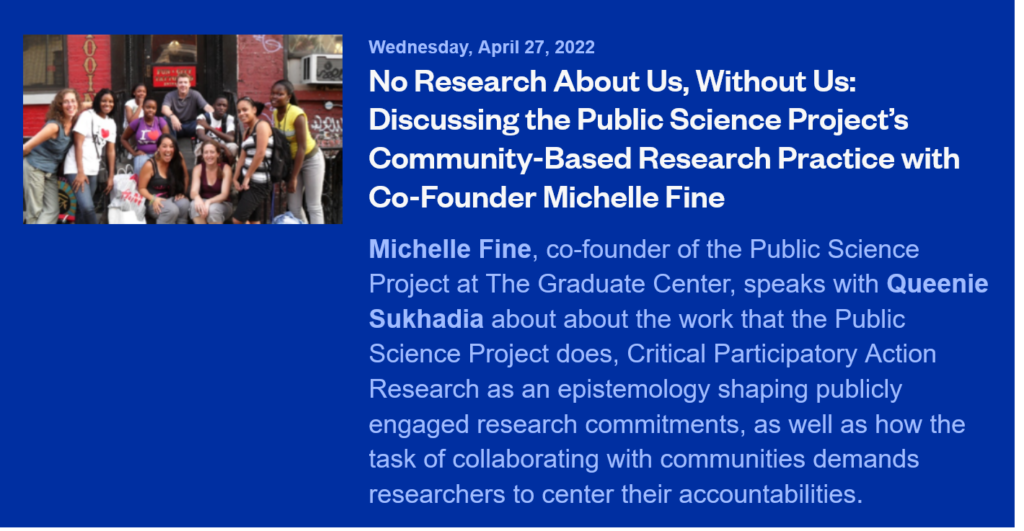
Click here to read this interview with Michelle Fine, co-founder of the Public Science Project at the CUNY Graduate Center.
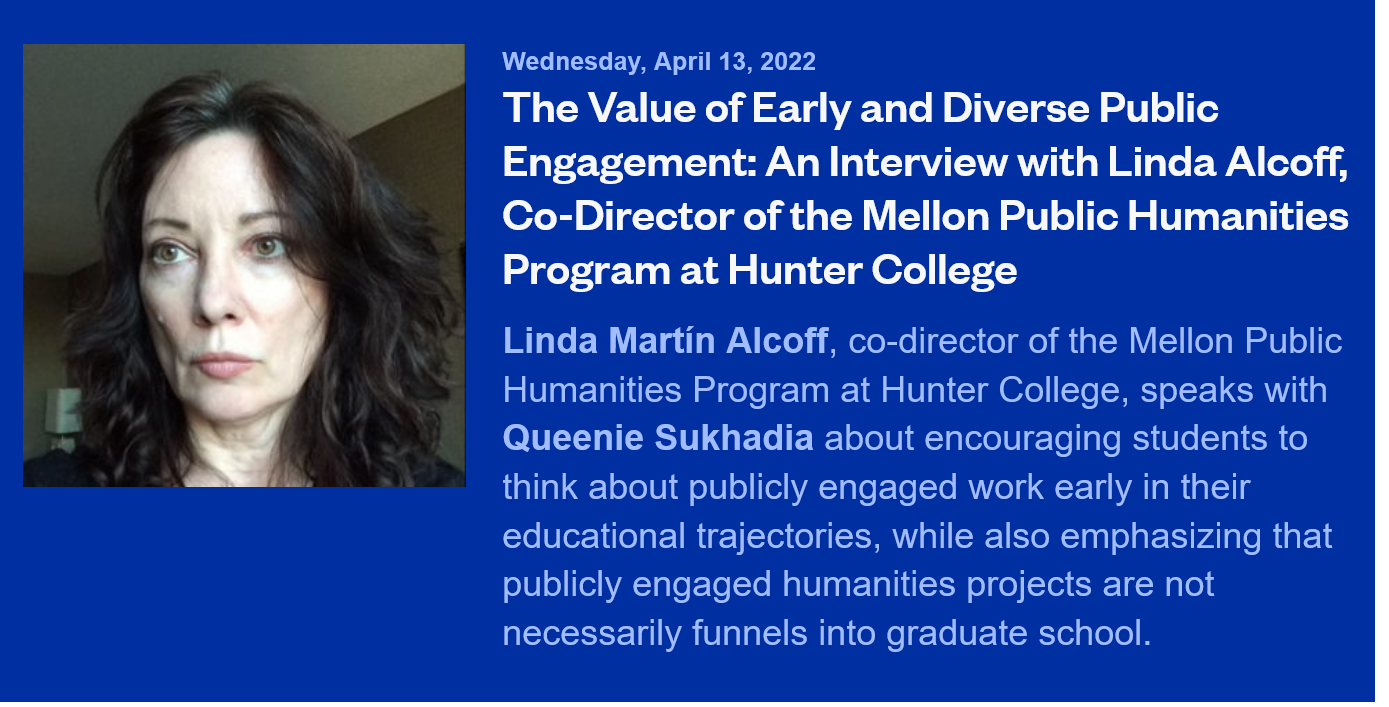
Click here to read this interview with Linda Alcoff, Co-Director of the Mellon Public Humanities Program at Hunter College.
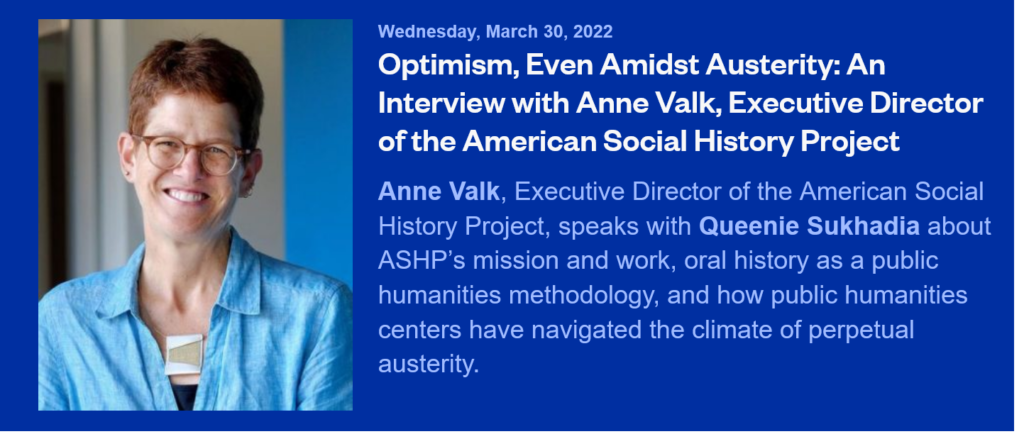
Click here to read this interview with Anne Valk, Executive Director of the American Social History Project at the CUNY Graduate Center.
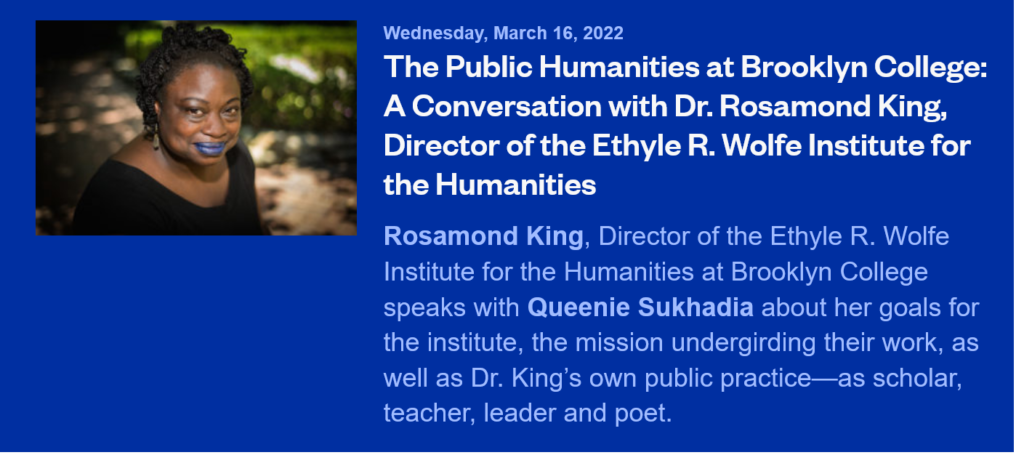
Click here to read this interview with Dr. Rosamond King, Director of the Ethyle R. Wolfe Institute for the Humanities at Brooklyn College.

Click here to read this interview with Dr. Stacy Hartman and Dr. Bianca Williams from the PublicsLab at the CUNY Graduate Center.
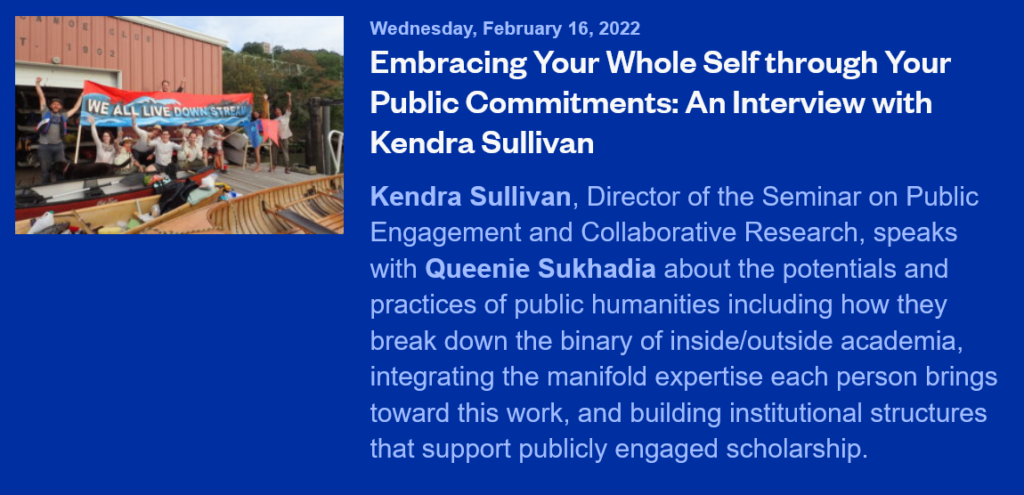
Click here to read this interview with Kendra Sullivan, Director of the Seminar on Public Engagement and Collaborative Research from the Center for the Humanities at the CUNY Graduate Center.
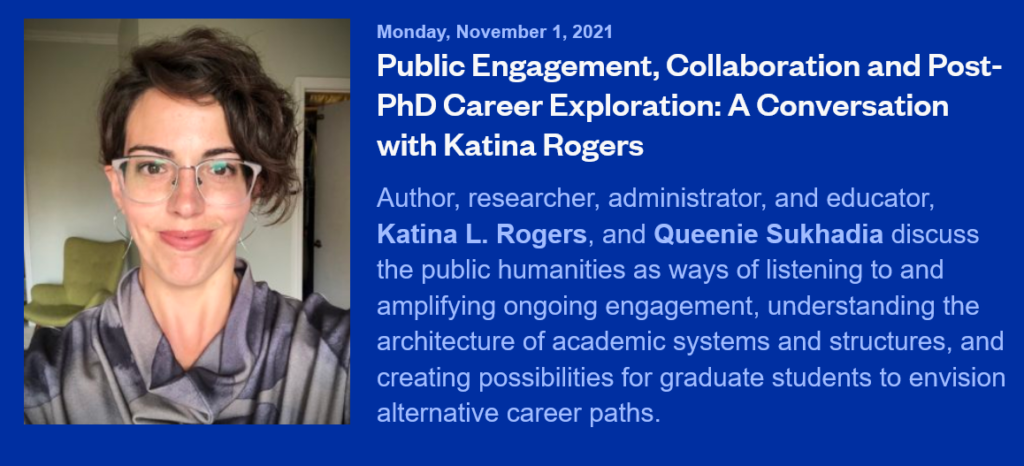
Click here to read this interview with author, researcher, administrator and educator, Katina L. Rogers.